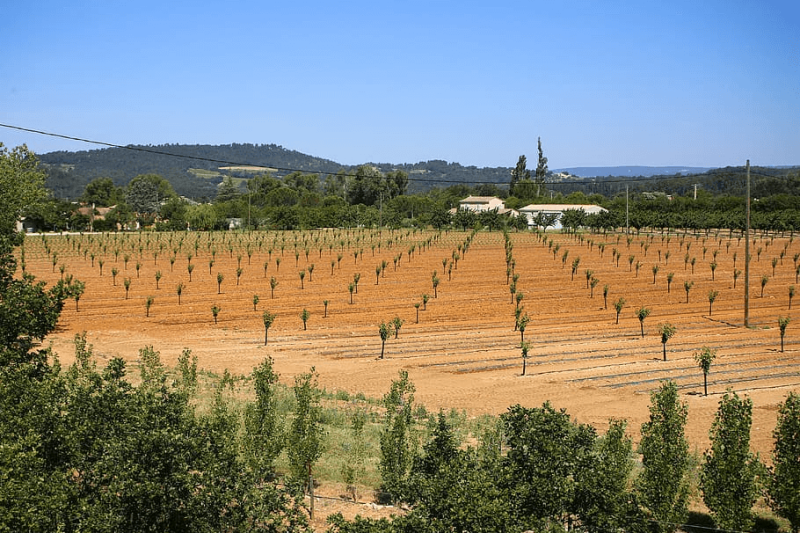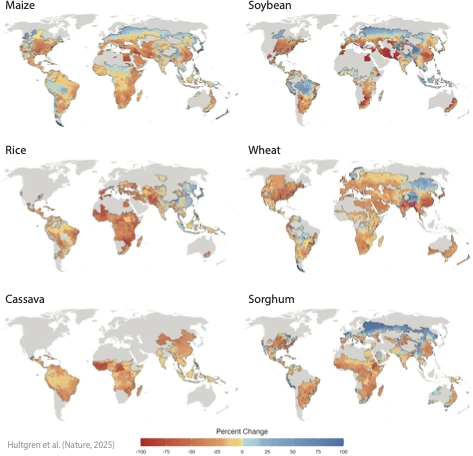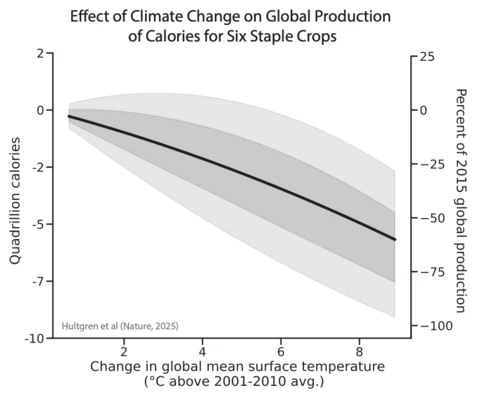Falling future yields: Farmers will be unable to adapt to destabilizing climate change
Falling future yields: Farmers will be unable to adapt to destabilizing climate change

The global food system faces growing risks from climate change, even as farmers seek to adapt, according to a June 18 study in Nature.
In contrast to previous studies suggesting that warming could increase global food production, the researchers estimate that every additional degree Celsius of global warming on average will drag down the world’s ability to produce food by 120 calories per person per day, or 4.4% of current daily consumption.

“When global production falls, consumers are hurt because prices go up and it gets harder to access food and feed our families,” said Solomon Hsiang, professor of environmental social sciences at the Stanford Doerr School of Sustainability and a senior author of the study. “If the climate warms by 3 degrees, that’s basically like everyone on the planet giving up breakfast.” That’s a high cost for a world where more than 800 million people at times go a day or more without food because of inadequate access.
The projected losses for U.S. agriculture are especially steep. “Places in the Midwest that are really well suited for present day corn and soybean production just get hammered under a high warming future,” said lead study author Andrew Hultgren, an assistant professor of agricultural and consumer economics at the University of Illinois Urbana-Champaign. “You do start to wonder if the Corn Belt is going to be the Corn Belt in the future.”
Hsiang and Hultgren worked on the analysis with more than a dozen scholars over the past eight years as a project with Climate Impact Lab, a research consortium that Hsiang co-directs with University of Chicago economist Michael Greenstone, Rutgers University climate scientist Robert Kopp, and climate policy expert Trevor Houser of the Rhodium Group.
“This is basically like sending our agricultural profits overseas. We will be sending benefits to producers in Canada, Russia, China. Those are the winners, and we in the U.S. are the losers,” said Hsiang. “The longer we wait to reduce emissions, the more money we lose.”
Limits to adaptation

The study draws on observations from more than 12,000 regions across 55 countries. The team analyzed adaptation costs and yields for crops that provide two-thirds of humanity’s calories: wheat, corn, rice, soybeans, barley, and cassava.
Previous studies failed to account for realistic adaptation by farmers, assuming either “perfect” adaptation or none at all. The new study is the first to systematically measure how much farmers adjust to changing conditions. In many regions, for example, they switch crop varieties, shift planting and harvesting dates, or alter fertilizer use.
The team estimates these adjustments offset about one-third of climate-related losses in 2100 if emissions continue to rise, but the rest remain. “Any level of warming, even when accounting for adaptation, results in global output losses from agriculture,” said Hultgren.
The steepest losses occur at the extremes of the agricultural economy: in modern breadbaskets that now enjoy some of the world’s best growing conditions, and in subsistence farming communities relying on small harvests of cassava. In terms of food production capacity from staple crops, the analysis finds yield losses may average 41% in the wealthiest regions and 28% in the lowest income regions by 2100.
Higher emissions bring bigger losses

The modeling points to a 50% chance that global rice yields will increase on a hotter planet, largely because rice benefits from warmer nights, while the odds that yields will decline by century’s end range from roughly 70% to 90% for each of the other staple crops.
With the planet already about 1.5 degrees Celsius hotter than pre-industrial levels, farmers in many areas are experiencing longer dry spells, unseasonable heat waves, and erratic weather that undermines yields, even when inputs like fertilizer and water improve.
The study modeled future crop yields under a range of warming and adaptation scenarios. By 2100, the authors estimate global crop yields would be dragged down 11% if emissions rapidly plummet to net zero and 24% if emissions continue to rise unchecked.
In the shorter term, by 2050 the authors estimate climate change will drag global crop yields down by 8% – regardless of how much emissions rise or fall in the coming decades. That’s because carbon dioxide emissions stay in the atmosphere, trapping heat and causing damage for hundreds of years. “If we ignore those long-run damages, we assign an economic value of zero to them, and that is clearly wrong,” Hultgren said.
New tools aim to help policymakers target resources
Hsiang, Hultgren, and colleagues are now working to help governments make informed decisions about where to direct adaptation investments, recognizing that many farmers still lack access to even basic agricultural resources, such as better fertilizer and accurate weather data.
The team is working with the United Nations Development Program to disseminate the new climate risk insights to governments around the world and developing a system to identify communities most at risk of yield declines and where targeted support can be most effective. “We’re focusing on how to make it so that this is not actually what our future looks like, even if we can’t get our act together on the emissions side,” Hsiang said.
A favorable climate, he added, is a big part of what keeps farmland productive across generations. “Farmers know how to maintain the soil, invest in infrastructure, repair the barn,” Hsiang said. “But if you’re letting the climate depreciate, the rest of it is a waste. The land you leave to your kids will be good for something, but not for farming.”
A version of this article was originally posted on Stanford University and is reposted here with permission. Any reposting should credit both the GLP and original article. Find Stanford University on X @Stanfordand Josie Garthwaite @journojos
 | Videos | More... |

Video: Nuclear energy will destroy us? Global warming is an existential threat? Chemicals are massacring bees? Donate to the Green Industrial Complex!
 | Bees & Pollinators | More... |

GLP podcast: Science journalism is a mess. Here’s how to fix it

Mosquito massacre: Can we safely tackle malaria with a CRISPR gene drive?

Are we facing an ‘Insect Apocalypse’ caused by ‘intensive, industrial’ farming and agricultural chemicals? The media say yes; Science says ‘no’
 | Infographics | More... |

Infographic: Global regulatory and health research agencies on whether glyphosate causes cancer
 | GMO FAQs | More... |

Why is there controversy over GMO foods but not GMO drugs?

How are GMOs labeled around the world?

How does genetic engineering differ from conventional breeding?
 | GLP Profiles | More... |

Alex Jones: Right-wing conspiracy theorist stokes fear of GMOs, pesticides to sell ‘health supplements’





 Viewpoint — Fact checking MAHA mythmakers: How wellness influencers and RFK, Jr. undermine American science and health
Viewpoint — Fact checking MAHA mythmakers: How wellness influencers and RFK, Jr. undermine American science and health Viewpoint: Video — Big Solar is gobbling up productive agricultural land and hurting farmers yet providing little energy or sustainabilty gains
Viewpoint: Video — Big Solar is gobbling up productive agricultural land and hurting farmers yet providing little energy or sustainabilty gains Fighting deforestation with CO2: Biotechnology breakthrough creates sustainable palm oil alternative for cosmetics
Fighting deforestation with CO2: Biotechnology breakthrough creates sustainable palm oil alternative for cosmetics Trust issues: What happens when therapists use ChatGPT?
Trust issues: What happens when therapists use ChatGPT? California, Washington, Oregon forge immunization alliance to safeguard vaccine access against federal undermining
California, Washington, Oregon forge immunization alliance to safeguard vaccine access against federal undermining 30-year-old tomato line shows genetic resistance to devastating virus
30-year-old tomato line shows genetic resistance to devastating virus The free-range chicken dilemma: Better for birds, but with substantial costs
The free-range chicken dilemma: Better for birds, but with substantial costs ‘You have to treat the brain first’: Rethinking chronic pain with Sanjay Gupta
‘You have to treat the brain first’: Rethinking chronic pain with Sanjay Gupta
